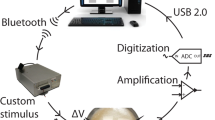Abstract
-
1.
A simplified model of the thalamocortical motor system (VL-MC) is proposed, containing as principal components, an integrator and a regulator. The integrator generates ramp functions, with the slope of the ramp determined by sensory (peripheral) input. The duration of the ramp function is controlled by the regulator. The regulator is assumed to be a higher order control system whose overall goal is to prevent the VL-MC system from shifting to an unstable (e.g. epileptiform) mode of operation.
-
2.
The VL-MC system has been investigated in cats utilizing 3 anesthetic agents; pentobarbital, chloralose and ketamine. The experimental results, when explained within the constraints of the model, were as follows: a) In the pentobarbital cases, ramp slopes were truncated by a negative slope of approximately equivalent magnitude. The ramp truncation mechanism (regulator) operates to limit the maximum amplitude of the ramp, resulting in a compensatory reduction in ramp duration for steeper ramp slopes. No cortical epileptiform activity was observed. b) In the chloralose cases, at a level of anesthesia where active nociceptive reflex action was present, steeper ramp slopes were observed which were not truncated by a negative slope of equivalent magnitude. Epileptiform spike activity was observed on motor cortex. The ramp truncation or regulatory mechanism appears to be significantly reduced in capacity, when chloralose is used as an anesthetic agent, as compared to pentobarbital. c) In the ketamine cases, the ramp generation mechanism appears to be completely disabled. No epileptiform activity was observed.
-
3.
It is suggested that a regulatory mechanism exists as a functional part of the thalamocortical motor system of the cat and that this regulatory mechanism plays a key role in preventing the system from shifting to an unstable mode, characterized by epileptiform cortical activity.
-
4.
A simplified model of the system has been implemented on an analog computer and suggests one possible design for the regulatory mechanism in terms of the variables measured and the parameters controlled.
Similar content being viewed by others
Referebces
Ashby, W.R.: An introduction to cybernetics. p. 207. New York: Wiley 1963
Angaut, P.: Anatomical and functional bases of cerebello-cerebral interrelations. J. Physiol. (Lond.) 67, 53–116 (1973)
Bickford, R.G., Klass, D.W.: Sensory precipitation and reflex mechanisms. In: Basic mechanisms of the epilepsies, pp. 543–564. (Eds.) Jasper, H.H., Ward, A.A., Pope, A. Boston: Little, Brown, and Co. 1969
Broggi, G., Margnelli, M.: Dynamic properties of synaptic input from intralaminar nuclei to ventrolateral neurons of the thalamus. Brain Res. 26, 192–194 (1971)
Coulter, N.A., Jr.: Toward a theory of teleogenetic control systems. Gen. Syst. 13, 85–89 (1968)
Desiraju, T., Purpura, D.P.: Organization of specific-nonspecific thalamic internuclear synaptic pathways. Brain Res. 21, 169–181 (1970)
Eccles, J.C., Sabah, N.H., Schmidt, R.F., Táboříková, H.: Mode of operation of the cerebellum in the dynamic loop control of movement. Brain Res. 40, 73–80 (1972)
Eccles, J.C.: The cerebellum as a computer: patterns in space and time. J. Physiol. (Lond.) 229, 1–32 (1973)
Frigyesi, T.L., Machek, J.: Basal ganglia-diencephalon synaptic relations in the cat. I. An intracellular study of dorsal thalamic neurons during capsular and basal ganglia stimulation. Brain Res. 20, 201–217 (1970)
Frigyesi, T.L., Machek, J.: Basal ganglia-diencephalon synaptic relations in the cat. II. Intracellular recordings from dorsal thalamic neurons during low frequency stimulation of the caudato-thalamic projection systems and the nigrothalamic pathway. Brain Res. 27, 59–78 (1971)
Frigyesi, T.L., Rabin, A.: Basal ganglia-diencephalon synaptic relations in the cat. III. An intracellular study of ansa lenticularis, lenticular fasciculus and pallidosubthalamic projection activities. Brain Res. 35, 67–87 (1971)
Gardner, M.R., Ashby, W.R.: Connectance of large dynamic (Cybernetic) systems: critical values for stability. Nature (Lond.) 228, (1970)
Hanna, G.R., Johnson, R.N.: A rapid and simple method for the fabrication of arrays of recording electrodes. Electroenceph. clin. Neurophysiol. 25, 284–286 (1968)
Ito, M.: Neurophysiological aspects of the cerebellar motor control system. Int. J. Neurol. 7, 162–176 (1970)
Ito, M.: Neural design of the cerebellar motor control system. Brain Res. 40, 81–84 (1972)
Johnson, R.N., Hanna, G.R.: The thalamocortical system as a neuronal machine: the interaction of ventrolateral nucleus with sensori-motor cortex in the cat. Brain Res. 18, 219–239 (1970)
Johnson, R.N., Hanna, G.R.: An elementary description of thalamocortical system dynamics in the cat. Brain Res. 31, 119–137 (1971)
Johnson, R.N., Hanna, G.R.: Modulation of the thalamocortical motor system by sensory information. Brain Res. 38, 35–47 (1972a)
Johnson, R.N., Hanna, G.R.: Peripheral control and central regulation in the thalamocortical motor system. T.I.T. J. Life Sci. 2, 89–99 (1972b)
Kayama, Y., Iwama, K.: The EEG, evoked potentials, and single unit activity during ketamine anestesia in cats. Anesthesiology 36, 316–328 (1972)
Nyquist, J.K., Towe, A.L.: Neuronal activity evoked in cat precruciate cerebral cortex by cutaneous stimulation. Exp. Neurol. 29, 494–512 (1970)
Powers, W.T.: Feedback: Beyond behaviorism. Science 179, 351–356 (1973)
Purpura, D.P.: Operations and processes in thalamic and synaptically related neural subsystems. In: The neurosciences: Second study program, pp. 458–470, Schmitt, F.O. (Ed.) New York: Rockefeller University Press 1970
Sparks, D.L., Corssen, G., Sides, J., Black, J., Kholeif, A.: Ketamine-induced anesthesia: Neural mechanisms in the rhesus monkey. Anesth. Analg. 52, 288–297 (1973)
Strick, P.L.: Light microscopic analysis of the cortical projection of the thalamic ventrolateral nucleus in the cat. Brain Res. 55, 1–24 (1973)
Winters, W.D., Spooner, C.E.: A neurophysiological comparison of alpha-chloralose with gamma-hydroxy-butyrate in cats. Electroenceph. clin. Neurophysiol. 20, 83–90 (1966)
Winters, W.D.: Epilepsy or anesthesia with ketamine. Anesthesiology 36, 309–312 (1972)
Author information
Authors and Affiliations
Rights and permissions
About this article
Cite this article
Johnson, R.N., Hanna, G.R. & Munzner, R.F. The thalamocortical motor system and stability: Observation of a possible regulatory mechanism. Biol. Cybernetics 18, 91–104 (1975). https://doi.org/10.1007/BF00337129
Received:
Issue Date:
DOI: https://doi.org/10.1007/BF00337129




